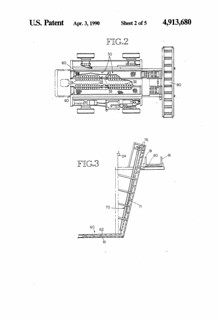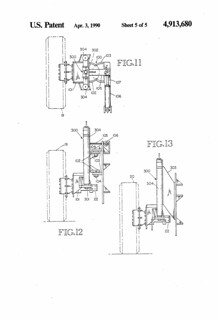
Today in 1954, US Patent 2674535 A was issued, an invention of Sidney S. Meisler, for his “Method and Means For Shipping or Storing Hops.” There’s no Abstract, but here’s how it’s described. “It is an object of the instant invention to provide better packing which will be impervious to Weather, negligent handling, and poor storing in the holds of ships where other cargos may contaminate the hops with odors, moisture, acids, etc., the hops being easily damaged. Another object is to conserve material in the shipment of hops.”
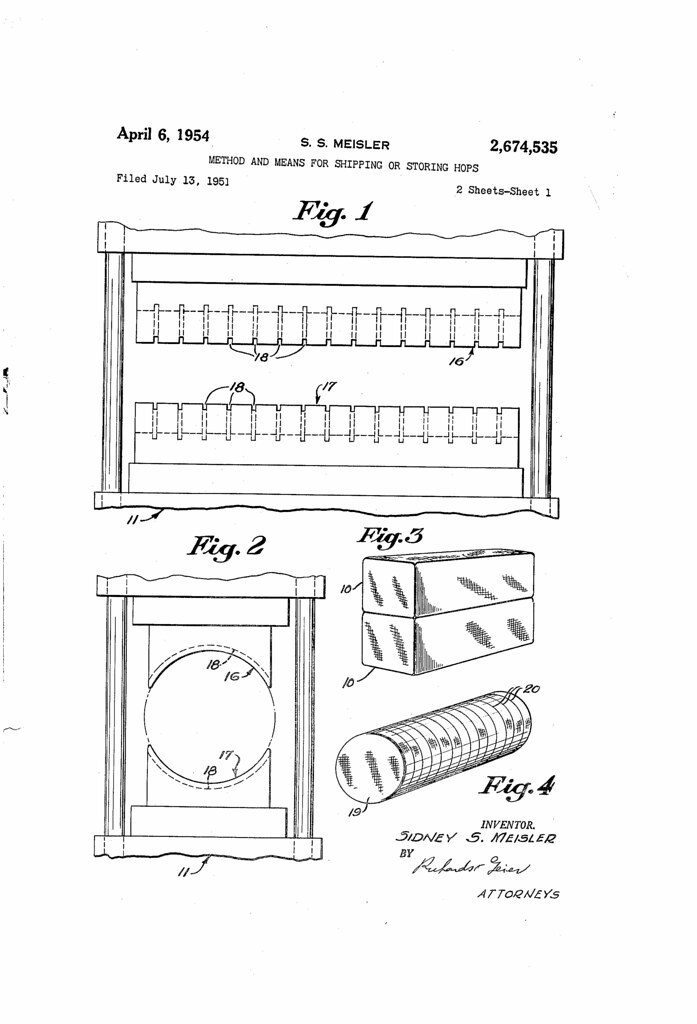

Patent No. 917019A: Apparatus For Mixing Liquids With Gases

Today in 1909, US Patent 917019 A was issued, an invention of Gustav Detlefsen, for his “Apparatus for Mixing Liquids with Gases.” There’s no Abstract, but here’s how it’s described. “This invention relates to an improved apparatus for mixing liquids with gases, the device being more particularly designed to charging beer with carbonic acid gas while the beer flows from the chip cask to the racking apparatus. The construction is such that the liquid is thoroughly agitated while being charged with the gas, so that an intimate mixture is obtained.”
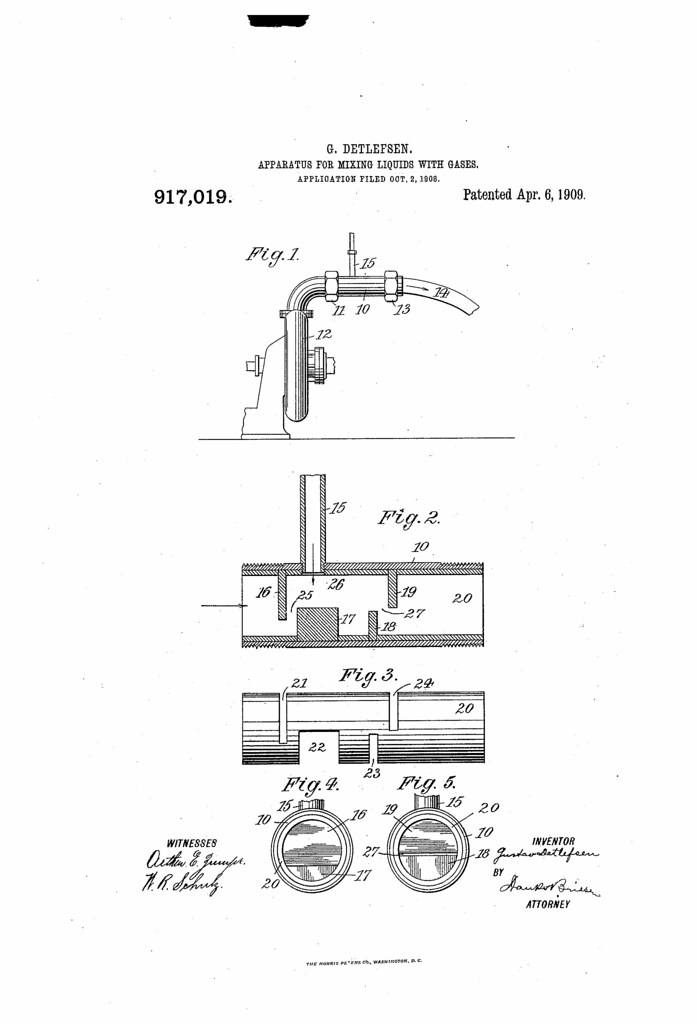
Patent No. 580104A: Apparatus For Manufacturing Beer Or Ale

Today in 1897, US Patent 580104 A was issued, an invention of Andrew Worthington Billings, for his “Apparatus for Manufacturing Beer or Ale.” There’s no Abstract, but here’s how it’s described. “It is the object of the invention to provide an apparatus by the use of which malt liquors may be manufactured in a simpler, quicker, and less expensive manner than heretofore and to effect the aeration of wort in the same apparatus in which the mashing and boiling take place. A further object of the invention is to insure the perfect sterilization of the air used in the aeration of the wort and to regulate the flow of such air in the manner hereinafter more particularly pointed out.”
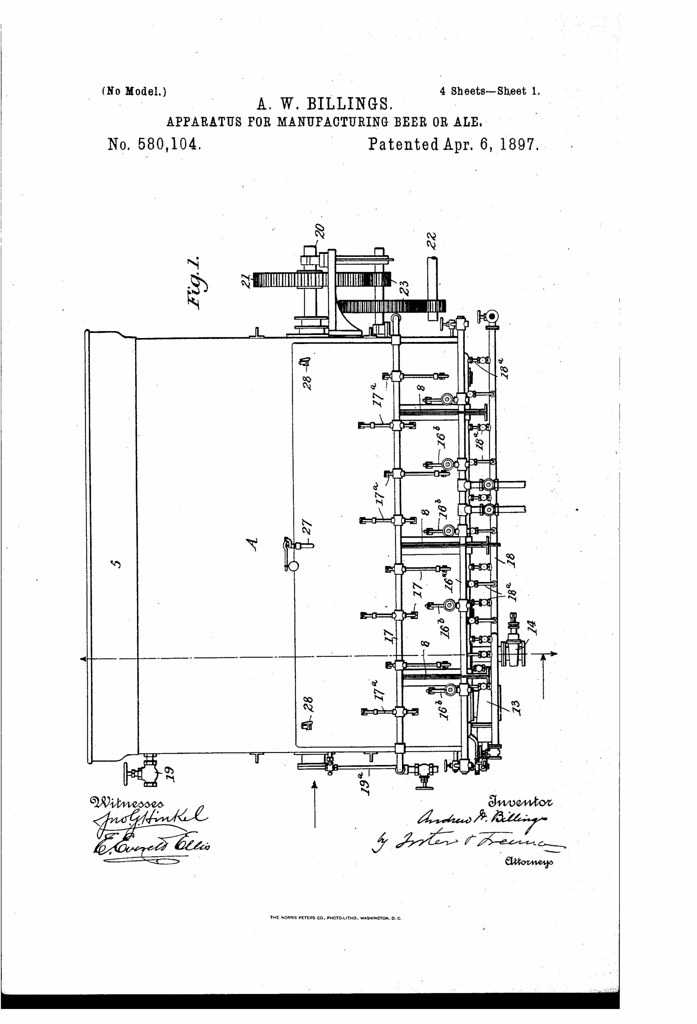
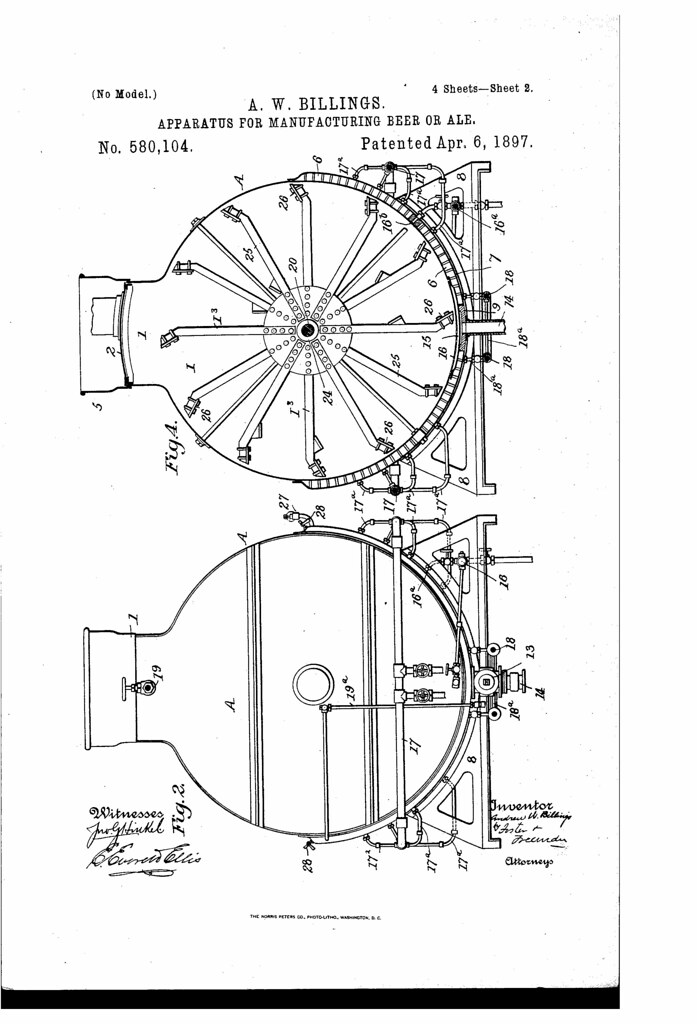


Patent No. 20070075089A1: Method Of Protecting The Open Top Of A Beer Can Against Contamination By Insects, Dirt And Debris

Today in 2007, US Patent 20070075089 A1 was issued, an invention of Thomas Stein, for his “Method of Protecting the Open Top of a Beer Can and a Soda Can Against Contamination by Insects, Dirt And Debris.” Here’s the Abstract:
A cover for the open top of a soda can or beer can is substantially round and has a pair of parallel sides together with an annular bevel or chamfer to accommodate either a soda can or a beer can. The beer can has a larger diameter at its annular rim than that of the soda can, so that (in use) the cover is reversed. The cover may contain a trademark, logo, company name or message for promotional purposes. An alternate cover is substantially half-round, and a further embodiment is substantially arcuate.

I think the best thing about his patent is the drawing illustrating all of the problems that this invention will fix or make better. They’re hilarious. How did we ever drink from cans before this?
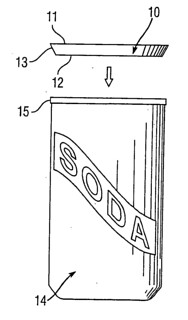

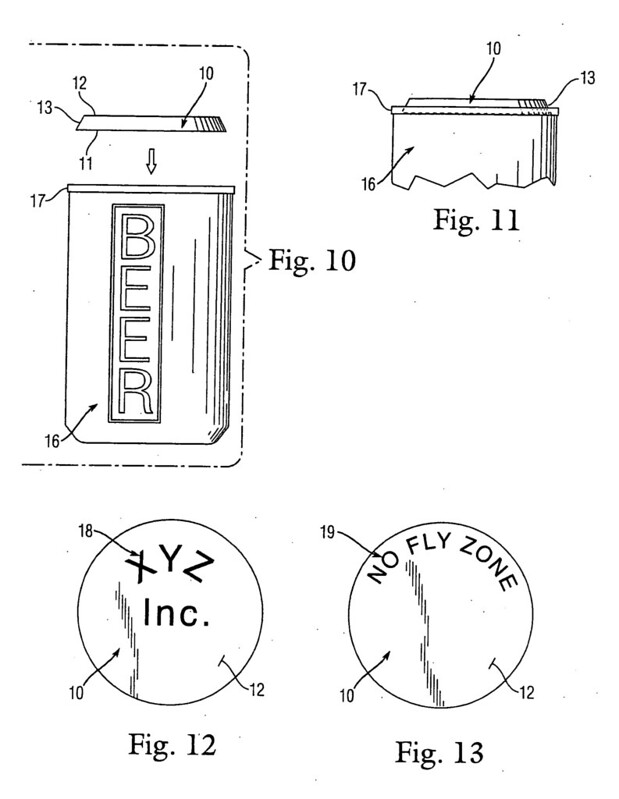
Patent No. 954397A: Keg-Rinser

Today in 1910, US Patent 954397 A was issued, an invention of Adolph C. La Budde, for his “Keg-Rinser.” There’s no Abstract, but here’s how it’s described:
The invention is an improvement in of all sizes, such as barrels, half barrel, quarter barrels and eighth barrels, and is designed to economize in labor and time; both in working the nozzle and the controlling valve or the water supply, and properly positioning the keg to receive the nozzle, as well as to make the rinsing more effectively
The invention in general consists of a water supply conduit having a nozzle and a controlling valve, a foot lever operable to simultaneously project the nozzle valve into the keg and open the valve, and rollers to support the keg over the nozzle, each roller tapering toward the center to conform to the keg and facilitate its movement to rinsing position.
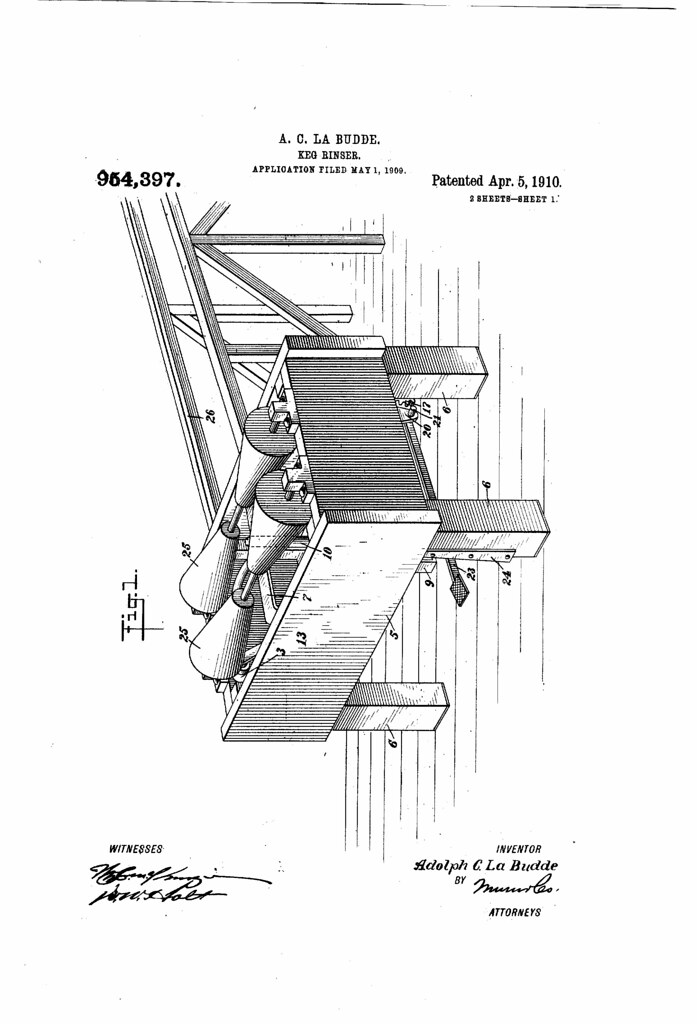

Patent No. D503550S1: Combined Beer Dispensing Cooler And Lawn Chair

Today in 2005, US Patent D503550 S1 was issued, an invention of Brian Miesieski, Devin Kelly, and Geoff Blanck, assigned to Labatt Brewing Company Ltd, for their “Combined Beer Dispensing Cooler and Lawn Chair.” There’s no Abstract, which is unusual for such a recent patent. The patent application merely lists the seven submitted drawings of the design and the only other text at all is this short claim. “The ornamental design for a combined beer dispensing cooler and lawn chair, as shown.”



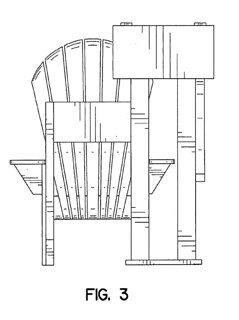

My first thought was this had to be a promotional item that Labatt used for some sales campaign. And, in fact, that’s what it was used for. I found a picture of the finished product, which also included this caption:
This unit was designed to promote Labatt’s “Blueprint” advertising campaign which was centered around a series of beer dispensers. This chair was featured on ABC’s“Good Morning America”, a nationally broadcast television show, as one of the “Best Gadgets For Your Life”. The cooler keeps 12 cans of beer ice cold while storing one can in a chilled holding pen. When the handle is pushed it releases the can in the holding pen and reloads itself.
And the Global Marketing Group of Fair Lawn, New Jersey, a marketing display company, currently lists the chair in their catalog under Unique Solutions. So you could still get your own beer can chair, if you really, really wanted one.
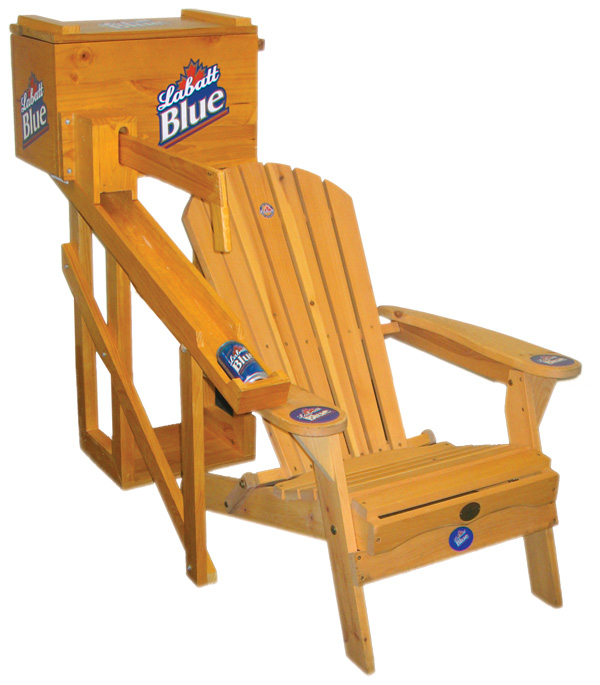
Patent No. 20130081661A1: Keg Washers

Today in 2013, US Patent 20130081661 A1 was issued, an invention of Stephen L. Hambly, assigned to Global Stainless Systems, Inc., for his “Keg Washers.” Here’s the Abstract:
Keg washers and locking mechanisms for keg washers are disclosed. The keg washers may include a base assembly, a cleaning head, a head mechanism, and a locking mechanism configured to secure the keg to the base assembly. The locking mechanism may include a holder mechanism and a neck holder fixedly mounted to the holder mechanism. The neck holder may include a first opening and a second opening. The holder mechanism may be configured, when the cleaning head is moved from a retracted position toward an extended position, to move the neck holder from a first position in which a first neck portion of a keg is received in the first opening but a second neck portion is not received in the second opening, to a second position in which the first neck portion is received in the first opening and the second neck portion is received in the second opening.



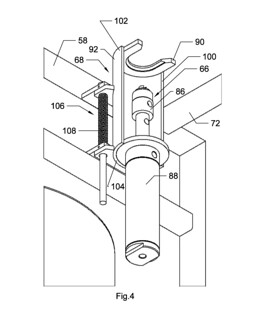

Patent No. 3653557A: Keg Sealing & Tapping Apparatus

Today in 1972, US Patent 3653557 A was issued, an invention of Kay R. Lamb, for his or her “Keg Sealing and Tapping Apparatus.” Here’s the Abstract:
An apparatus for sealing and tapping containers for pressurized liquids such as beer kegs and the like including a resilient valve plug mounted in the tap hole of a keg and tap head removably mounted on the keg having an inner liquid delivery tube and an outer fluid supply tube extending downwardly through the valve plug into the keg to allow pressurized fluid to be supplied to the keg through the fluid supply tube and liquid to be withdrawn from the keg through the liquid delivery tube. The plug has integral valve means arranged to seal against the outer fluid supply tube when the head is mounted on the container, and which is adapted to close and seal the container when the head is removed.
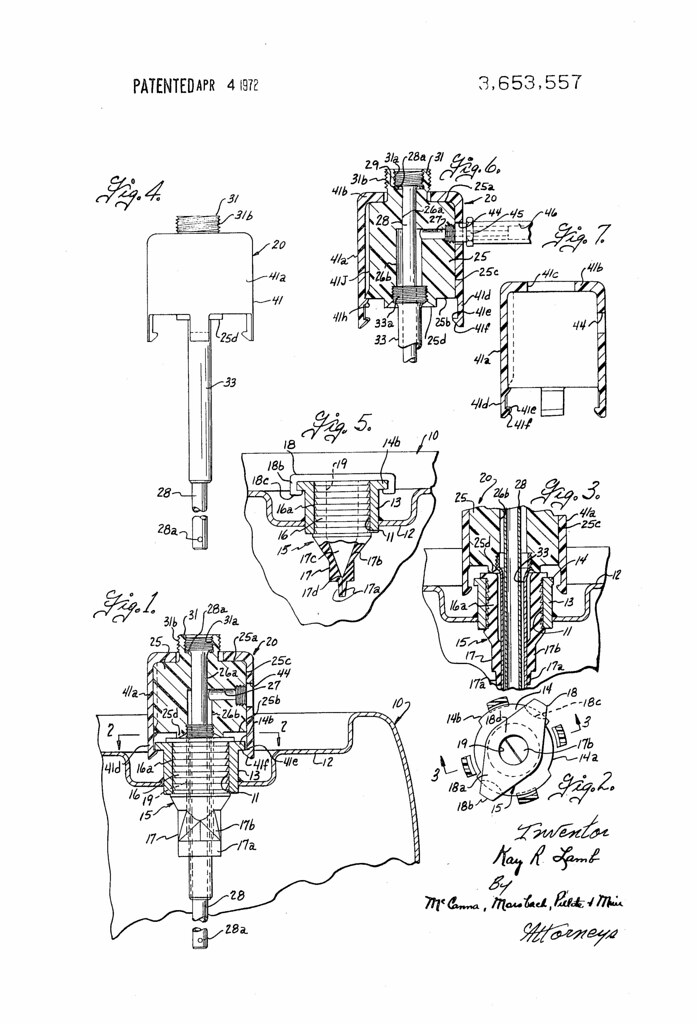
Patent No. 2372854A: Yeast

Today in 1945, US Patent 2372854 A was issued, an invention of Gustave T. Reich, for his “Yeast.” There’s no Abstract, but the descriptions states that the “invention relates to yeast and its production and it is particularly directed to a method of improving the quality of yeast obtained in the alcoholic fermentation of saccharine materials, particularly sugar rellnery materials such as black-strap molasses. It also claims to improve yeast production in twelve different ways, and then lists each way, if you’re curious.

Patent No. 4913680A: Low-Trellis Mobile Hop Picker

Today in 1990, US Patent 4913680 A was issued, an invention of Donald A. Desmarais, for his “Low-Trellis Mobile Hop Picker.” Here’s the Abstract:
A mobile hop picking machine is provided with independently elevatable wheels. The picker straddles a trellis to position opposing picking cats on either side of the vines. Front and rear banks of picking hooks move upwardly to pick the hops. A bank of resilient raking tines comb the vines upwardly between the picking banks. The picking cats are pivoted about their front edges and are supported for transverse movement on their rear edges. Cylinders urge the rear of the cats toward the vines. A contact member connected to the cat moves the cat transversely, to avoid cat contact with poles, against a biased mounting provided for the hydraulic cylinder. Longitudinal conveyors transport the hops rearwardly and upwardly. A squeeze conveyor floats on a top support over the elevating end of the longitudinal conveyors. An alternate arrangement intersperses the raking tines and picking hooks.

